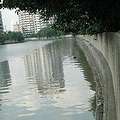 亞洲開發銀行的資深官員7日在全球水資源週會議開議前表示,許多亞洲國家由於缺乏衛生基礎建設的投資,所以在清潔環境上面臨極大的財務負擔,而這也導致地表水和地下水的大規模污染。
亞洲開發銀行的資深官員7日在全球水資源週會議開議前表示,許多亞洲國家由於缺乏衛生基礎建設的投資,所以在清潔環境上面臨極大的財務負擔,而這也導致地表水和地下水的大規模污染。
大約有20億亞洲人,相當於亞洲66%的人口缺乏完善的衛生設施,例如厠所、茅坑、廚餘槽和污水下水道系統。而這個數字大概佔全球面臨類似情況人口數的3/4。
亞洲開發銀行的主要城市發展專員隆恩(Amy Leung)表示,「若不試圖解決衛生與污水問題,人類終將自食惡果;河川將會變得惡臭、腐敗甚至淤塞,城市及其周遭的環境也將跟著惡化。」
她接著說:「然而,真正可怕的是因衛生缺乏而使傷寒及霍亂大流行。」
隆恩表示,目前亞洲開發銀行約有16億美元規劃完成的經費,計劃從現在到2010年要投資於衛生基礎建設上,並且設法將這個投資數字擴大為2倍或3倍。
「世界水資源週」(World Water Week)是個全球性的會議場合,旨在建立能力與合作關係,且伴隨著國際水資源與發展專案的實施。
亞洲銀行的官員表示,清理一條被工業廢棄物或污水污染的河川所需的花費,遠遠高於建造能夠適當處置污染物之設施的成本。
 例如在上海,中國當局必須花10億美元去清理蘇州河,這條河流經都會區,對於居民的健康曾經是一種危害。而且,官員也承認,清理成本是一開始即投入污染防治成本的好幾倍。
例如在上海,中國當局必須花10億美元去清理蘇州河,這條河流經都會區,對於居民的健康曾經是一種危害。而且,官員也承認,清理成本是一開始即投入污染防治成本的好幾倍。
中國2006年公佈投資1250億美元在衛生基礎建設與廢水處理的計劃上。亞洲銀行官員表示,這是重要的進展,但仍不足以滿足其人民的需求。
這充份顯示,從現在到2015年的聯合國千禧年發展目標年期間,亞洲在衛生與廢水處置基礎建設上所需要的投資規模有多麼大。
Many Asian countries face huge financial costs to clean up the environment because of a lack of investment in sanitation. This is leading to massive pollution of both surface water and groundwater, senior officials of the Asian Development Bank said today ahead of a global clean water conference.
Some two billion Asians – roughly 66 percent of the population in Asia – lack access to adequate sanitation, such as toilets, pit latrines, septic tanks, and sewerage systems. This accounts for nearly three-quarters of all those in the world without such facilities.
"Failure to act on sanitation and wastewater eventually comes home to roost when the problem results in a smelly, foul, turgid river that despoils a city and surrounding areas," said Amy Leung, principal urban development specialist with the Asian Development Bank, ADB.
"But the real horror is the outbreak of typhoid and cholera caused by inadequate sanitation," she said.
Leung says the bank has about $1.6 billion in the pipeline for investments in sanitation between now and 2010 and is looking for ways to double or triple that figure.
World Water Week is the global meeting place for capacity and partnership building and following up on the implementation of international water and development programs.
The financial cost of cleaning a river once it is already polluted with industrial waste or sewage is far higher than the cost of building the infrastructure needed to dispose of the pollutants properly, bank officials say.
In Shanghai, for example, Chinese authorities had to spend $1 billion to clean Suzhou Creek, which runs through the metropolis and used to be a health risk to residents. Officials acknowledge cleanup costs were many times what would have been needed to prevent the pollution in the first place.
China last year announced plans to invest $125 billion in sanitation and wastewater treatment, a major step forward but still not enough to meet its people's needs, say bank officials.
This indicates the magnitude of investment needed in Asia for sanitation and wastewater infrastructure between now and 2015, the target date for accomplishing the UN's Millenium Development Goals.
全文及圖片詳見ENS


